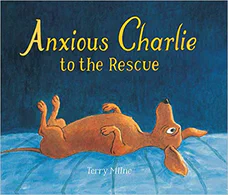Anxious Charlie to the Rescue

Recommended Age Range: Preschool through 1st grade.
Publisher's Summary:
Charlie follows the same routine every day: he hops out of bed in the morning, walks the same route to the market, and lines up his stuffed animals just so in the evening. If anything is slightly different, Charlie worries that something bad might happen. But when friends call one morning asking for Charlie’s help, he forgets to follow his usual routine. Will something bad happen, as Charlie fears? Or will he learn that change can be good? In this touching story by Terry Milne, readers will fall in love with the nervous little dog named Charlie and his ability to overcome his fear of change.

Dr. Annie's Takeaways
Recommended for: This book is best for a child who has a type of OCD with compulsive rituals (e.g., counting a number of steps, tapping different items, etc.). Children with this type of OCD will likely relate to dachsund Charlie and enjoy seeing him be the hero of the story. For therapists, this book is a light, fun introduction to Exposure and Response Prevention
.
Would a child like it? A child who relates to Charlie will love seeing that he’s the hero. His friends love him and turn to him in a time of need, OCD and all.
Evidence-Based Practices:
Exposure and Response Prevention (ERP)
Tone: Cheerful, cute
Story Quality: I love that this story is about more than Charlie conquering his OCD, although it is also about that. He saves his friend and is a hero, and he’s able to do so by resisting his compulsions. The story makes it clear that Charlie is more than his OCD (he’s a good friend and a creative problem solver), and the rescue plot makes for an engaging story.
Illustrations: Adorable, fairly realistic watercolor illustrations. Charlie is quite cute.
Representation: Charlie is a male dachshund who has compulsive rituals he feels he needs to perform everyday or “something bad would happen.” He has several animal friends (a Bull Terrier named Hans, a Great Dane named Big Bruce, a cat, and a duck). Charlie has to rescue Hans from a pipe where he got stuck playing hide-and-seek. The animals live in a suburban or rural human world and do human things (play Simon Says, eat toast, water plants with a watering can).
Psychological Practices: This book gently introduces the idea that if a child is able to resist doing a compulsion, they may learn that nothing bad happens, and, in fact, that something “wonderful” could happen. Charlie the dachshund has a morning ritual that he feels he has to do every morning: he hops three times, balances his toast on his nose for three seconds, waters his plants in the same order, walks once around the fire hydrant, and goes the same direction around a tree. At bedtime he checks under the bed and behind the curtains and arranges his toys in a row. He says to himself as he falls asleep, “I remembered everything today, and things turned out OK.” He states that if he doesn’t do the rituals, “something bad would happen.” When he has to rush to rescue his friend, there isn’t time to complete his ritual properly, and although he wants to start over, he overrides this urge because he wants to rush to help his friend. That night, he has the thought, “I forgot everything today, but things turned out OK.” The next day, he leaves off part of his morning ritual on purpose and expresses hope that the outcome will be something “wonderful.” Of course, for most children who relate to Charlie, it’s not as easy as this, but it’s a solid introduction to the concept of Exposure and Response Prevention
and a sweet non-stigmatizing portrayal of OCD.
Concerns: None
